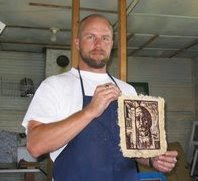 Repetitive Pump in Purple, 2006, Acrylic on Canvas, 12" X 36"
Repetitive Pump in Purple, 2006, Acrylic on Canvas, 12" X 36"The text, though difficult to read, is about Randy Cunningham, a congressman convicted of accepting bribes for war related government contracts.
During the first gulf war I considered myself lucky as I was on my way home from a west-pac when Iraq invaded Kuwait. I missed my girlfriend and thought I finally knew what it was to be an American. Believe me, no one knows what it means to be American until they've been away from it, they only suspect. I paid my respects to those who gave their lives for my country in Pearl Harbor as we manned the rails when we pulled into port. I lost countrymen and acquaintances over the Mariana Trench off the coast of Japan as their helo went down and no bodies were recovered. This time was served in the defense of my nation; it was an honor to serve.
Along with that honor comes a certain amount of trust. I trusted, as as most sailors and soldiers do, in the judgment of our civilian leaders to be deployed in our nations defense. Now I've come to understand that defense is not always clear as at times service in small military actions can defend my nation such as a call to certain commitments for the United Nations. Yet I trust that these too are for the protection of life and nothing less. This service is not for a way of life (and by that I do not mean fundamental values of my nations such as liberty and equality but in the sense of certain conveniences we've come to expect as Americans, like football on Sunday or disposable coffee cups on our way to work) but for life itself. My trust appears to have been betrayed as my service has been at least partly for the protection of American business interests. As if I was not defending my country or the freedom of my countrymen but the market for a few industry leaders. Now, I must point out this does not mean my service was not honorable or that the lives of American servicemen and women that were lost or altered in the service of our country was in any way less than honorable, I am saying that the trust we put in our civilian leadership has been betrayed.
No blood for oil! It has not been shed for oil but for country. Those that betrayed our trust must be held accountable. They know there has been blood for oil.
